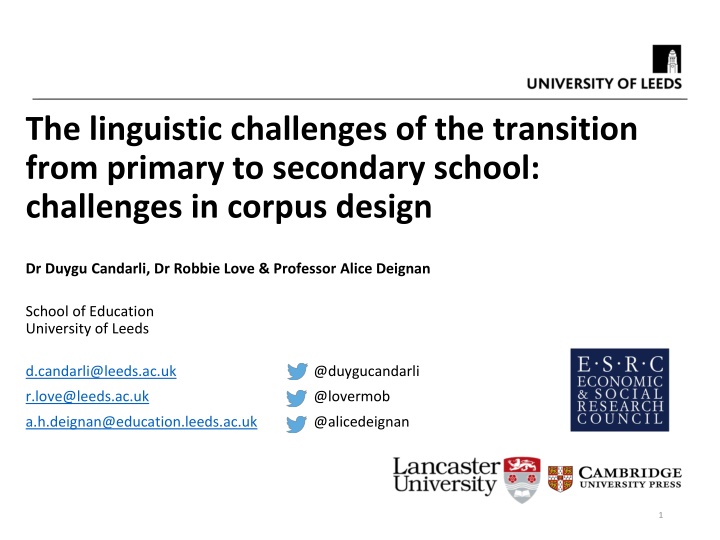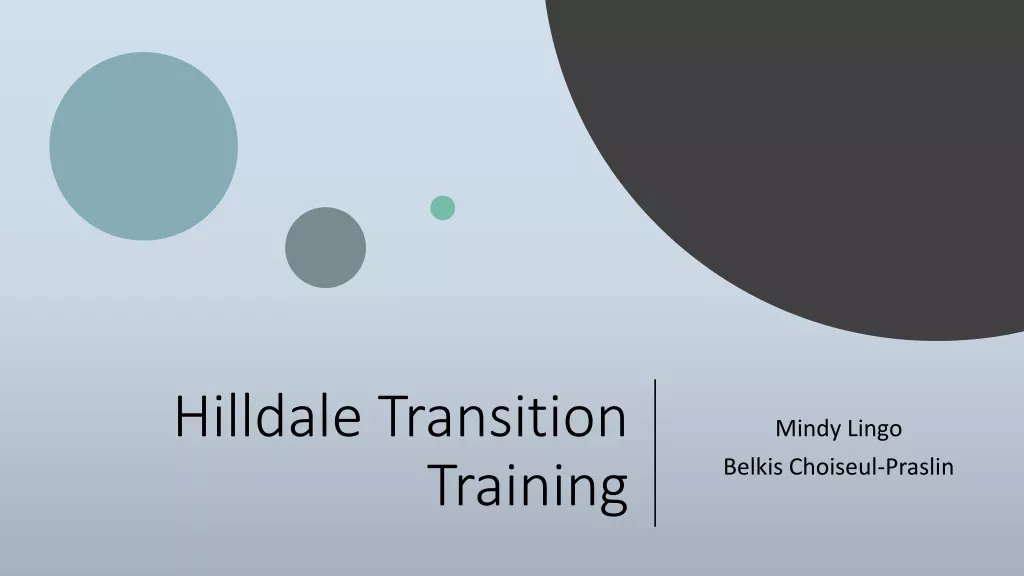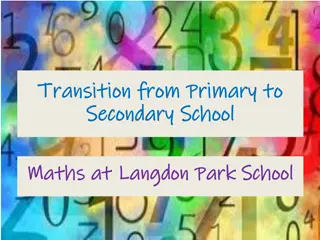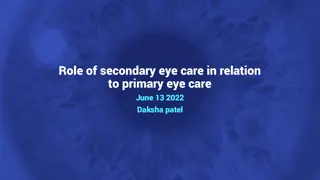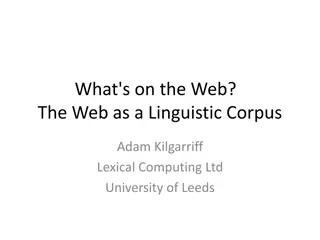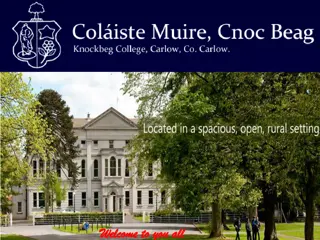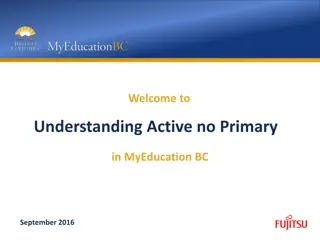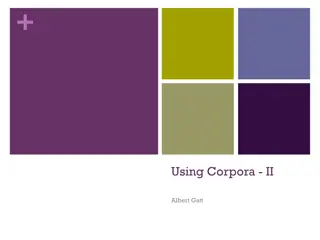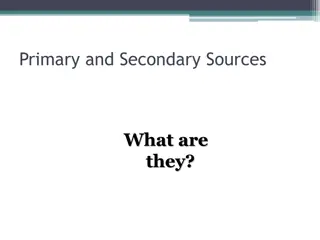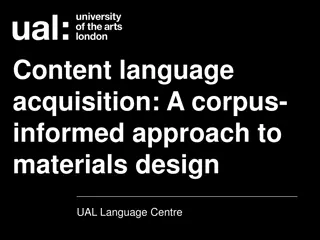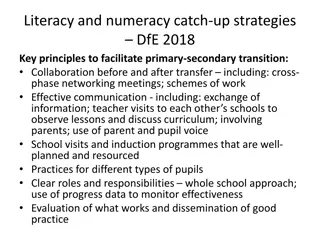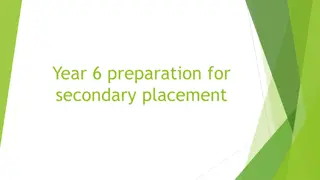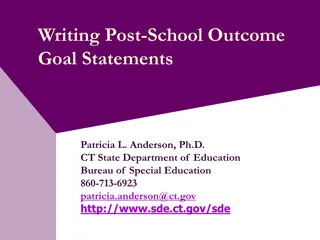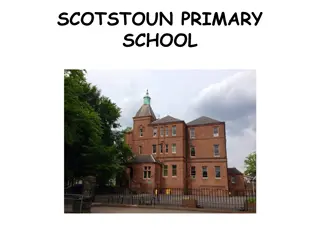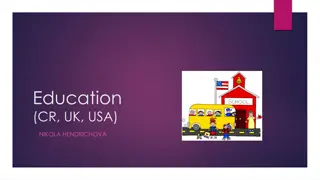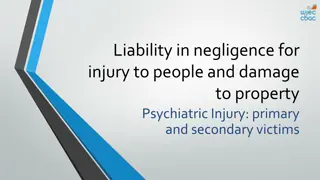Challenges in Transition from Primary to Secondary School: Corpus Design
The linguistic challenges in transitioning from primary to secondary school in England are explored in this project. The focus is on academic school language and the barriers students face in understanding the curriculum, particularly at the start of Key Stage 3. The differing registers of academic language, including the instructional and regulative registers, are crucial in academic learning. The project delves into the language expectations placed on students in academic contexts and aims to address the linguistic demands that students encounter during this critical educational transition.
Download Presentation

Please find below an Image/Link to download the presentation.
The content on the website is provided AS IS for your information and personal use only. It may not be sold, licensed, or shared on other websites without obtaining consent from the author.If you encounter any issues during the download, it is possible that the publisher has removed the file from their server.
You are allowed to download the files provided on this website for personal or commercial use, subject to the condition that they are used lawfully. All files are the property of their respective owners.
The content on the website is provided AS IS for your information and personal use only. It may not be sold, licensed, or shared on other websites without obtaining consent from the author.
E N D
Presentation Transcript
The linguistic challenges of the transition from primary to secondary school: challenges in corpus design Dr Duygu Candarli, Dr Robbie Love & Professor Alice Deignan School of Education University of Leeds d.candarli@leeds.ac.uk @duygucandarli r.love@leeds.ac.uk @lovermob a.h.deignan@education.leeds.ac.uk @alicedeignan 1
Plan England s school system Background to the project Research questions Challenges in corpus design and data collection Discussion 2
Background: English state schools Key Stage Early years Year Nursery Reception Age 3-4 4-5 Key Stage 1 Key Stage 2 Years 1 & 2 Years 3-6 5-7 7-11 Primary school Key Stage 3 Key Stage 4 Years 7-9 Years 10 & 11 11-14 14-16 Secondary school Key Stage 5 Years 12 & 13 16-18 3
Background: the project Many students in England find the transition from primary to secondary school difficult (DfE 2011; Howe & Richards 2011; Evangelou et al. 2008; Brooks 2016) - social reasons - larger school - change in friendship groups - being the youngest again - tougher academic demands - tougher linguistic demands? 4
Academic school language The language of school comprises numerous registers, not all of them academic Our focus is on academic registers = school language i.e. the instructional / regulative registers of academic learning Comprises overlapping subject-specific registers (Christie 2002; Christie & Derewianka 2008) academic activities are associated with a kind of language that is different from that used in everyday activities (Leung 2014: 137) 5
Academic school language Students writing has been extensively researched in the UK education contexts (e.g. Durrant & Brenchley 2018; Nesi & Gardner 2012) We are interested in the language that students receive in academic contexts at school What are they expected to understand and respond to in order to access the curriculum? 6
School language & the transition Dip in attainment at start of Key Stage 3 Difference in language as a barrier to understanding the curriculum? [t]eaching environments [ ] and teachers language are very different in secondary schools from primary schools (Braund & Driver 2005: 78) Children are able to think but they can't articulate their thoughts because of the lack of language [ ] it is not the concepts they are finding difficult at Key Stage 3, it is the ability to access material given to them. Interview with history teacher 7
What might be unfamiliar at KS3? A few ideas academic and semi-technical words multiword verbs grammatical metaphor tendency to compress information into complex noun groups use of passive voice subordination and other complex embedding unfamiliar discourse structures in both speaking and writing 8
Research questions RQ1: What are the linguistic characteristics of texts that students are required to understand and respond to at Key Stage 2, in terms of lexis, grammar and discourse? RQ2: What are the linguistic characteristics of texts that students are required to understand and respond to at Key Stage 3, in terms of lexis, grammar and discourse? RQ3: How does the language of Key Stage 3 vary according to subject area? RQ4: How does the language of Key Stage 3 differ from the language students have previously encountered, at the levels of lexis, grammar and discourse? RQ5: How do teachers and students perceive the linguistic challenges of the transition from primary to secondary school? 9
The project Linguistic challenges of the transition from primary to secondary school ESRC-funded, 2018-2021 University of Leeds Alice Deignan (PI) Gary Chambers (Co-I), Michael Inglis (Co-I) Duygu Candarli (RF), Robbie Love (RA) Lancaster University Elena Semino (Co-I), Vaclav Brezina (Co-I) Advisors/consultants Niall Curry (CUP), Marcus Jones (Huntington School), Constant Leung (KCL) 10
Project plans the first comprehensive and systematic description of the academic registers of secondary school with focus on how they differ from primary school and non-specialist language outside the school engaging with a range of schools in England building corpora of spoken and written academic language that students encounter at end of KS2 and start of KS3 corpus analysis to compare to each other, & across subjects, & to reference corpora of British English, including the BNC2014 plus, interviews with students / teachers about their views on the transition 11
Challenges in design and data collection 12
School recruitment So far 11 schools Yorkshire 3 secondary schools, 4 primary schools Newcastle 1 secondary school, 3 primary schools Things at schools change far quicker than in the academy... 13
Corpus design - background Interviews with school teachers Curriculum (timetable and distribution of lesson time) Literature review Representativeness - what are we trying to sample? 14
Corpus design Written corpora (Key Stage 2 and Key Stage 3) Teacher-designed worksheets Textbooks Exams, rubrics PowerPoint presentations Vocabulary/glossary booklets Web-based exercises (maths) Spoken corpora (Key Stage 2 and Key Stage 3) Audio recordings of lessons Subjects: English, maths, sciences, history, geography 15
Representativeness Science lessons in secondary schools Textbooks 20% - sampling the textbooks Worksheets 60% Marking rubrics 20% English lessons in secondary schools Fiction Of Mice and Men, Private Peaceful 16
Representativeness Text length Size of the corpus Key Stage 2 and Key Stage 3 Short texts (< 100 words at Key Stage 2) Written vs spoken Other variables that we cannot control 17
Example texts Year 5 (156 words) Year 6 (355 words) 18
Example texts Year 7 ( > 3000 words) 19
Example texts Year 8 ( > 1000 words) 20
Early findings - 1 The keywords in Maths written sub-corpus at Key Stage 3 in comparison to Key Stage 2 Single-words Keyness Effect size mean +71.96 0.01 data +67.8 0.01 median +56.02 0.009 mode +52.56 0.008 pie +43.55 0.007 factors +39.4 0.006 range +34.56 0.005 multiple +31.79 0.005 prime +29.02 0.005 average +28.33 0.004 21
Keywords at Key Stage 3 Data Each group has a statement, a set of data and one extra piece of data to make the statement true. (KS3_M8_3) Match these types of data to their meanings. Primary data Secondary data . (KS3_M8_8) 22
Early findings - 2 The key multi-words in Maths written sub-corpus at Key Stage 3 in comparison to Key Stage 2 Multi-words Score pie chart +1299.83 prime number +547.88 bar chart +513.7 same time +342.8 total number +308.62 ascending order +240.26 perfect number +171.9 square root +171.9 frequency table +171.9 high degree +137.72 23
Keywords at Key Stage 3 The same time Challenge! Two Formula 1 cars race around a track. The first car take 54 seconds to complete a lap. The second car is slower and takes 63 seconds. After how many seconds will they be at the starting place at exactly the same time? (KS3_M7_12) A green light flashes every 8 seconds, a red light flashes every 15 seconds. After how many seconds will they both flash at the same time? (KS3_M7_9) 24
Discussion Does the transition from KS2 and KS3 present language barriers which prevent students from accessing the curriculum? We believe that the transition to secondary school seems to involve a step change in academic language, which is likely to be especially difficult for children from lower SES backgrounds We aim to investigate this in order to inform the design of more accessible curricula for all students 25
Discussion design and data collection Representativeness, representativeness, representativeness... Designing a sampling frame is much more complicated than we first expected Responsiveness to changes at schools Schools are very keen, but we have learned to expect the unexpected Communication & avoiding intrusion 26
Thank you https://linguistictransition.leeds.ac.uk/ @LeedsTransition d.candarli@leeds.ac.uk @duygucandarli r.love@leeds.ac.uk @lovermob 27
References Braund, M. & Driver, M. (2005). Pupils' perceptions of practical science in primary and secondary school: implications for improving progression and continuity of learning. Educational Research, 47, 77-91 Christie, F. (2002). Classroom discourse analysis: A functional perspective. London: Continuum. Christie, F. & Derewianka, B. (2008). School discourse: Learning to write across the school years. London: Continuum. Coxhead, A. (2000). A new academic word list. TESOL Quarterly, 34, 213 238. Cummins, J. (1980). The cross-lingual dimensions of language proficiency: implications for bilingual education and the optimal age issue. TESOL Quarterly, 14(2), 175-187. Cummins, J. (2008). BICS and CALP: Empirical and theoretical status of the distinction. In Street, B. & Hornberger, N. H. (Eds.). (2008). Encyclopedia of Language and Education, 2nd Edition, Volume 2: Literacy. (pp. 71-83). New York: Springer Science & Business Media LLC. Cummins, J. (2014). Beyond Language: Academic communication and student success. Linguistics and Education, 26, 145-154 Deignan, A., Semino, E., & Paul, S. (2017). Metaphors of climate science in three genres : research articles, educational texts, and secondary school student talk. Applied Linguistics, 1 26. Department for Education. (2011). How do pupils progress between Key Stages 3 and Research Report. Durrant, P., & Brenchley, M. (2018). Development of vocabulary sophistication across genres in English children s writing. Reading and Writing. Howe, A., & Richards, V. (2011). Bridging the transition from primary to secondary school. Abingdon: Routledge. Kyle, K., Crossley, S. A., & Berger, C. (2018). The tool for the analysis of lexical sophistication (TAALES): Version 2.0. Behavior Research Methods, 50, 1030-1046. Leung, C. (2014). Researching language and communication in schooling. Linguistics in Education, 26, 136-144. Love, R., Dembry, C., Hardie, A., Brezina, V., & McEnery, T. (2017). The Spoken BNC2014: designing and building a spoken corpus of everyday conversations. In International Journal of Corpus Linguistics, 22(3), 319-344. Nesi, H., & Gardner, S. (2012). Genres across the disciplines: Student writing in higher education. Cambridge: Cambridge University Press. Simpson Vlach, R., & Ellis, N. C. (2010). An academic formulas list: New methods in phraseology research. Applied Linguistics, 31, 487 512. 28
